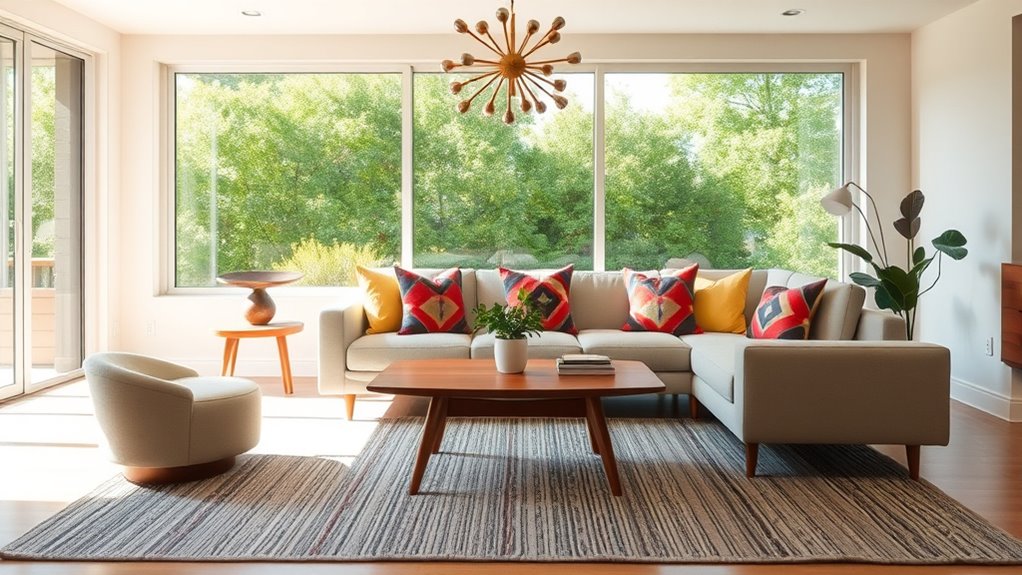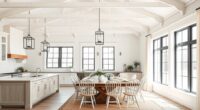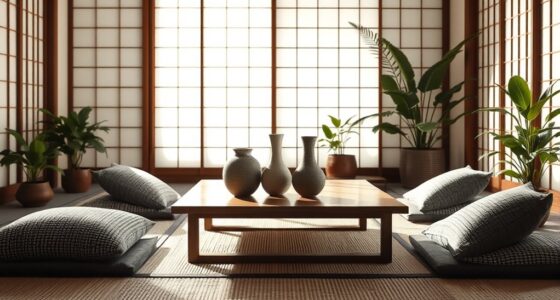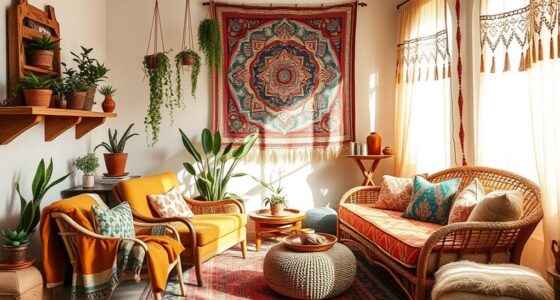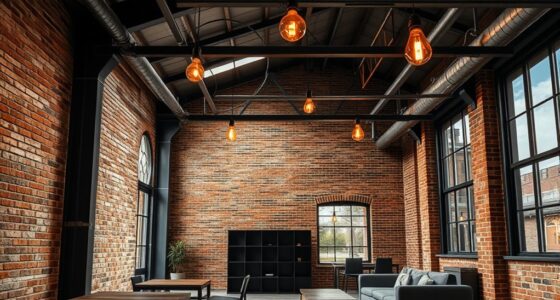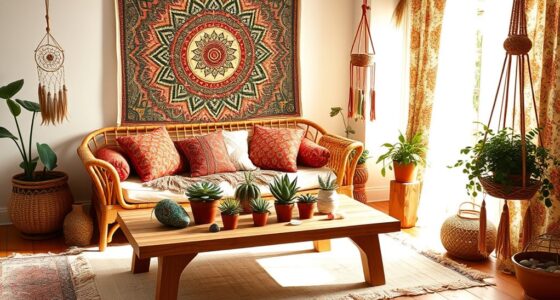Mid-century modern shifted from being a forgotten retro style to a must-have by constantly evolving through media exposure, nostalgia, and its timeless design principles. Its clean lines, organic shapes, and natural materials suit modern spaces, while iconic furniture and architecture remain highly desirable. Popularized by movies, TV shows, and social media, it now bridges vintage charm with contemporary trends. Keep exploring to discover how this style keeps shaping modern aesthetics and design trends.
Key Takeaways
- Media exposure in movies, TV shows, and social media popularized mid-century modern as stylish and desirable.
- Nostalgic revival and pop culture references reignited interest among new generations and interior designers.
- Iconic furniture pieces became symbols of modern elegance, boosting their status as must-have collectibles.
- Contemporary brands and sustainable practices integrated mid-century modern elements into modern homes.
- Design trends shifted from retro nostalgia to timeless appeal, emphasizing functionality and authentic craftsmanship.
The Post-War Roots and Global Rise of Mid-Century Modern
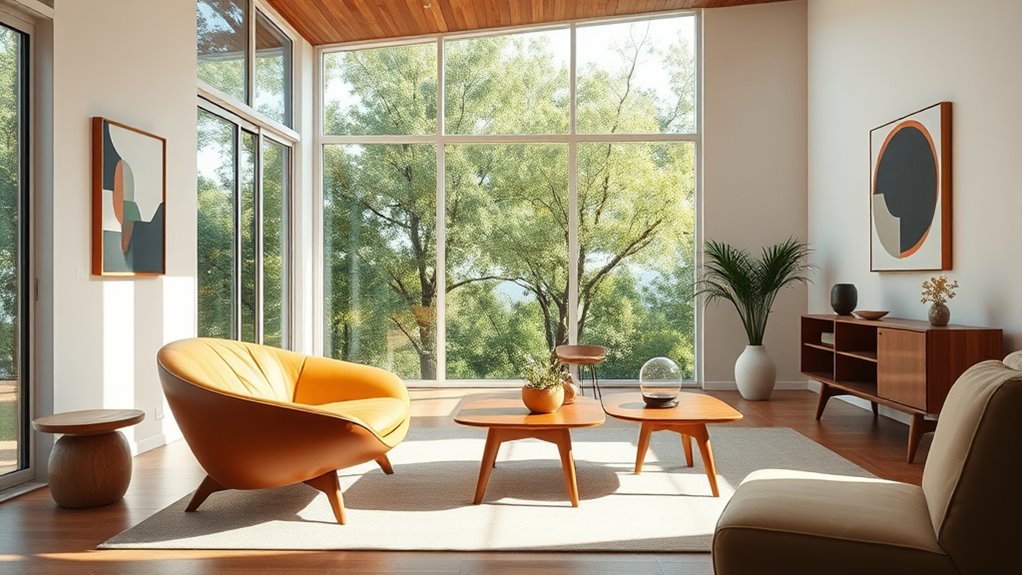
After World War II, mid-century modern design emerged in the United States, reflecting a shift toward minimalism and functionality. Its post-war roots stem from a desire for affordable, mass-produced furniture and architecture that embraced new materials like plywood, fiberglass, and plastics. This design movement was fueled by post-war optimism, technological progress, and a cultural embrace of innovation and nature. Influential exhibitions, such as the 1949 California Design show, showcased groundbreaking work by designers like Charles and Ray Eames and Eero Saarinen, helping spread its appeal. The movement’s ideas quickly gained international recognition, transforming from a regional trend into a global influence. Its iconic furniture and architectural landmarks continue to shape modern design, illustrating the movement’s lasting legacy.
Defining Features and Notable Designers of the Movement
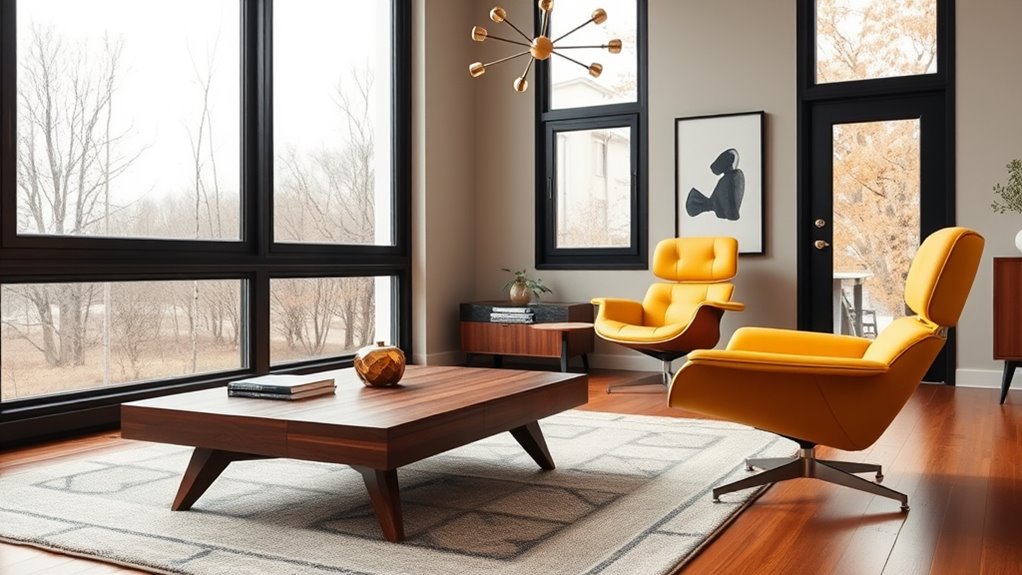
Mid-century modern design is defined by its clean lines, organic shapes, and a strong focus on functionality, often utilizing natural materials like wood, leather, and stone. You can spot it in sleek furniture pieces and architectural elements that emphasize simplicity and practicality. You can also observe the use of warm color palettes that evoke a cozy and inviting atmosphere characteristic of the style. Notable designers include Charles and Ray Eames, known for their innovative use of molded plywood and fiberglass, and Eero Saarinen, famous for his Tulip Table. Other key figures are George Nelson, Hans Wegner, and Arne Jacobsen, each creating iconic designs that stand the test of time. These designers pushed the boundaries of Mid-century Modern designs through innovative use of new materials. Their work exemplifies design innovation that continues to influence contemporary interiors worldwide, inspiring a blend of form and function that remains relevant today. Additionally, the movement’s emphasis on minimalist aesthetics has helped shape modern interior design principles, making it a lasting influence. Visualize streamlined chairs, minimalist tables, and functional yet stylish pieces that continue to influence contemporary interiors worldwide.
Cultural Impact and Media Influence Over the Decades
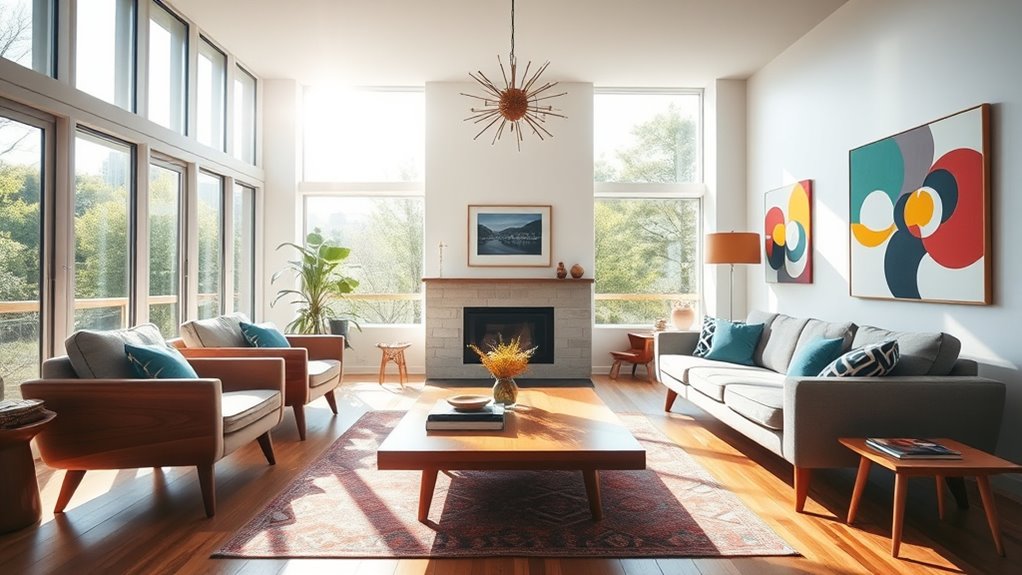
You’ve probably noticed how mid-century modern design keeps popping up in movies, TV shows, and ads, often highlighting iconic pieces like the Eames lounge chair to evoke style and nostalgia. These images of sleek architecture, like the TWA Flight Center, have become symbols of innovation thanks to media exposure. The movement’s enduring appeal is fueled by its repeated resurgence in pop culture, social media, and design trends across generations. Additionally, media representations often emphasize automation in business, showcasing how technology continues to shape aesthetic preferences and functional design elements. The influence of media has also contributed to a greater appreciation of design aesthetics, making mid-century modern styles a timeless and adaptable choice for contemporary interiors. This ongoing visibility has helped cement mid-century modern as a design movement that resonates with both vintage enthusiasts and modern homeowners alike. Moreover, the portrayal of remote work environments featuring mid-century modern furniture and decor has further reinforced its relevance and appeal in today’s lifestyle. The media’s focus on interior design trends has played a significant role in maintaining its popularity and relevance among new generations of design enthusiasts.
Media Spotlight and Exposure
- Iconic films depicting sleek, stylish interiors
- Magazine features emphasizing design innovation
- TV revivals igniting renewed interest
- Online platforms expanding reach
- Vintage markets showcasing collectibles
- Social media trends further popularize the aesthetic and introduce it to new audiences through music therapy integration techniques that emphasize mood and ambiance. Additionally, the influence of visual culture from the mid-century era continues to shape modern design narratives across various media, with digital content consumption playing a significant role in this ongoing cultural dialogue.
Iconic Furniture in Films
Iconic furniture pieces like the Eames Lounge Chair and Noguchi Coffee Table have become more than just design statements—they’re powerful visual tools in film and television that shape our perception of style and sophistication. These mid-century modern pieces are frequently featured in media representations to evoke a sense of modern elegance, nostalgia, and timeless appeal. Films like *Mad Men* and series like *Breaking Bad* showcase iconic mid-century furniture to establish character and setting, making these items symbols of sleek design and innovation. Their presence in popular media has elevated their status, fueling a global interest in furniture and decor inspired by mid-century modern pieces. As a result, these visual cues continue to influence fashion, interior design, and collector markets worldwide. The visual language of design in media has played a crucial role in popularizing mid-century modern aesthetics across generations. Additionally, the consistent use of these pieces in media has helped to solidify their cultural significance, ensuring their place in both historical and contemporary design narratives. Furthermore, the portrayal of these items has contributed to a perception of mid-century modern furniture as a symbol of luxury and modernity, which has influenced consumer preferences and interior styling choices. The ongoing integration of these iconic pieces in media underscores their importance as cultural symbols that transcend mere decoration.
Cultural Nostalgia and Rebirth
Media portrayals have played a pivotal role in reviving interest in mid-century modern design, making it resonate with new generations. The nostalgia for the 1950s and 1960s, fueled by pop culture hits like *Mad Men*, sparked a cultural resurgence that emphasized sophistication and retro-chic style. Vintage furniture and decor from that era became highly sought-after collectibles, igniting a design revival that crossed mainstream boundaries. Documentaries such as *Objectified* and *The Toys That Made Us* elevated mid-century modern to a cultural phenomenon. Social media platforms like Instagram and Pinterest further amplified its reach, inspiring a global audience. Visual imagery like:
- Sleek teak sideboards and starburst clocks
- Iconic Eames lounge chairs in modern living rooms
- Retro color palettes blending with contemporary decor
- Vintage posters celebrating mid-century design
- Curated Instagram feeds showcasing stylish interiors which harness AI content clustering to connect related images and ideas seamlessly.
The Evolution of Mid-Century Modern in Contemporary Spaces
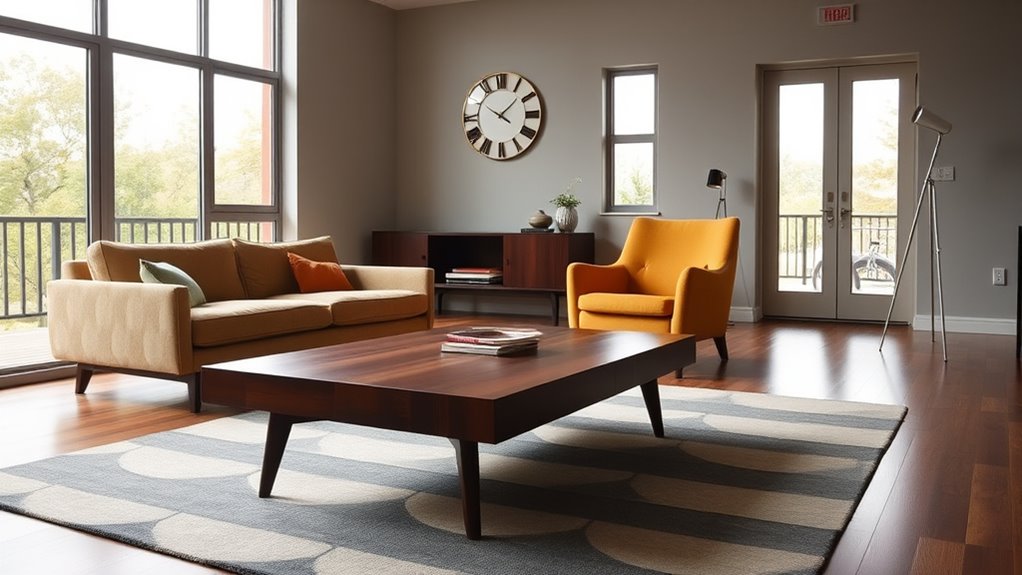
Mid-Century Modern has evolved seamlessly into contemporary interiors by blending authentic vintage pieces with modern reproductions. You’ll find iconic design elements like tapered legs, organic shapes, and natural materials integrated into today’s spaces, reflecting the movement’s timeless appeal. This adaptability is partly due to the movement’s emphasis on sustainable practices, such as repurposing vintage furniture and choosing eco-friendly materials, ensuring the movement remains relevant and environmentally conscious. Additionally, the integration of interior design principles allows for more intentional and cohesive space planning that enhances functionality and aesthetic appeal. Incorporating farmhouse furniture elements such as reclaimed wood and distressed finishes can further enhance its rustic charm. Understanding foraging techniques and local resource availability can inspire sustainable material choices in design and renovation projects. Exploring material sourcing methods can help designers and homeowners find authentic and eco-friendly materials that honor the movement’s roots. Its influence extends into popular media and furniture brands, where contemporary collections draw inspiration from Mid-Century Modern principles. As a result, Mid-Century Modern continues to shape the way you experience stylish, functional, and sustainable spaces today.
Differentiating Authenticity From Reproductions and Reimaginings
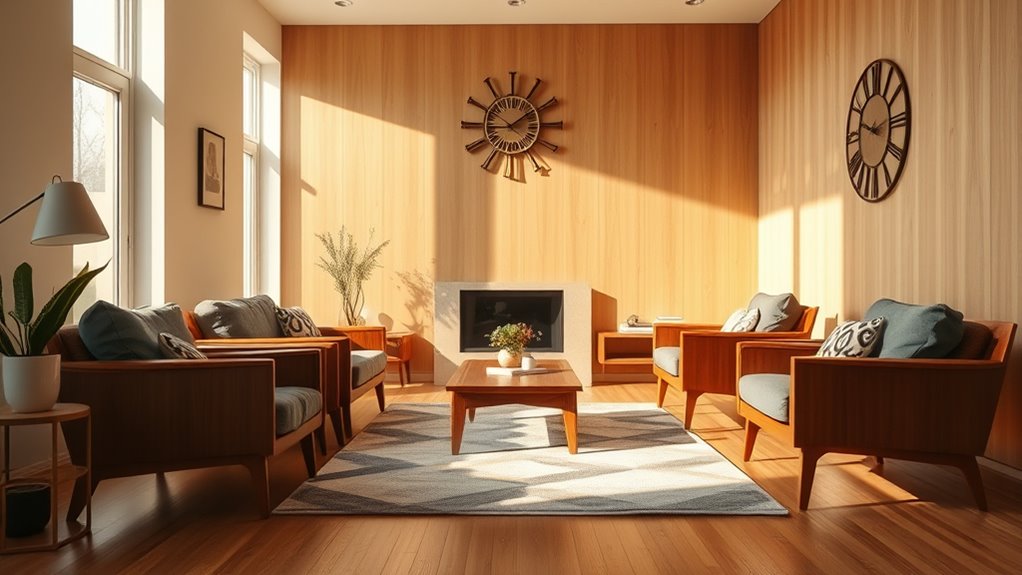
To tell if a piece is authentic, look for clear manufacturer marks, signatures, and high-quality craftsmanship. Authentic furniture is made with original materials like teak or walnut, while reproductions often use cheaper substitutes. Paying attention to these details helps you distinguish genuine mid-century pieces from imitations. Additionally, consulting architectural solutions can provide insights into authentic design elements and craftsmanship standards.
Authentic Markings and Labels
Authentic mid-century modern furniture often carries distinct labels or markings from well-known manufacturers like Herman Miller, Knoll, or signatures from designers such as Arne Jacobsen. These identifiers are vital for verifying authenticity and help distinguish original pieces from reproductions. Look for:
- Branded labels sewn or glued inside drawers or underneath surfaces
- Serial numbers stamped on the underside or back
- Manufacturing stamps indicating date, location, or factory
- Signatures or initials inscribed by the designer
- Clear, consistent markings matching known manufacturer styles
These markings make identification straightforward, giving you confidence in your purchase. Reproductions often lack these authentic labels or feature modern branding that doesn’t match original manufacturer stamps. Recognizing these details ensures you’re investing in genuine mid-century modern furniture.
Craftsmanship and Material Quality
Examining the craftsmanship and materials of a piece can reveal whether it’s genuine or a reproduction. Authentic mid-century modern furniture showcases high-quality craftsmanship, with details like tapered legs, precise joinery, and hand-finished surfaces that highlight skill and care. The use of natural materials such as solid hardwoods—oak, walnut, and teak—and durable metals like chrome and brass, speaks to its authenticity. Genuine pieces often bear labels, signatures, or stamps from well-known designers, confirming their origin. Reproductions and reimaginings tend to use cheaper, mass-produced materials like particleboard, pressed wood, or plastic, lacking the craftsmanship details and natural finish of authentic items. Recognizing these subtle differences helps you distinguish true mid-century modern furniture from imitations.
The Movement’s Enduring Appeal in Today’s Design Trends
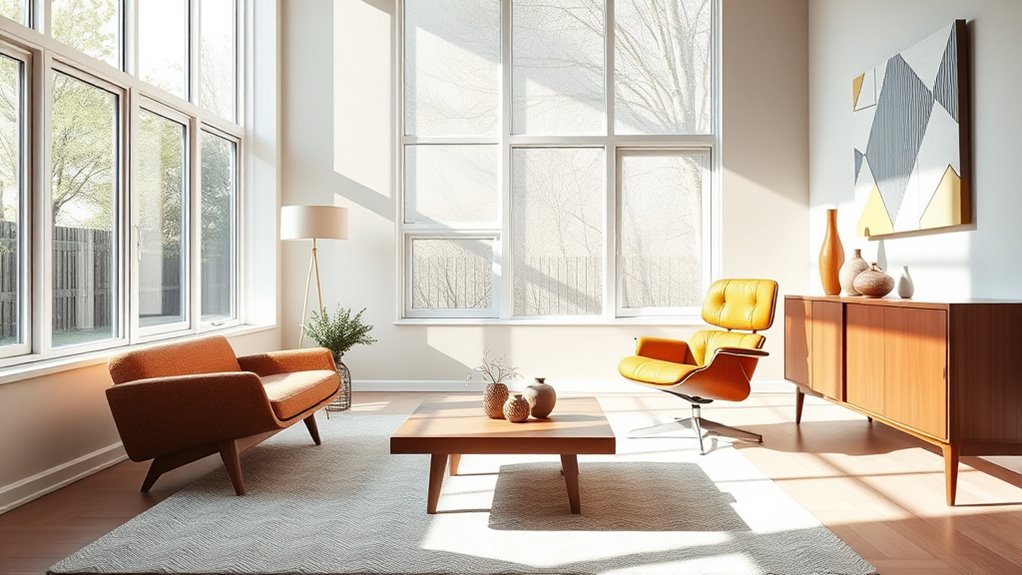
Mid-Century Modern’s clean lines and organic shapes continue to captivate designers and homeowners alike because their simplicity and versatility effortlessly complement a wide range of contemporary styles. Its timelessness stems from iconic designs that remain relevant, while natural materials add warmth and authenticity. This style’s versatility allows it to blend seamlessly with minimalist, eclectic, or even industrial interiors. Its enduring appeal is reinforced by the frequent appearance of iconic furniture and architectural elements in modern media, keeping the movement fresh and desirable. Collectors and designers value the durability and craftsmanship of Mid-Century Modern pieces, ensuring its relevance. Its adaptability to various lifestyles and eco-conscious values makes it a perennial favorite in today’s evolving design landscape.
Mid-Century Modern’s timeless appeal blends iconic design, natural materials, and versatile styles for enduring relevance.
- Sleek, clean-lined furniture fitting modern spaces
- Organic, natural materials creating warmth and texture
- Iconic designs that evoke nostalgia yet stay current
- Versatility to match diverse interior styles
- Enduring craftsmanship fueling ongoing appreciation
How Modern Homes Incorporate Mid-Century Elements

Modern homes embrace mid-century modern design by incorporating elements like clean-lined furniture, open floor plans, and expansive windows that seamlessly connect indoor and outdoor spaces. This style emphasizes simplicity and functionality through architectural features such as flat or low-pitched roofs and minimalist detailing. In your space, natural materials like wood and stone add warmth and authenticity to the modern interior design. You’ll often see iconic mid-century furniture pieces, like Eames lounge chairs or tulip tables, serving as focal points that elevate the overall aesthetic. The color palette typically combines neutral tones with bold accents, while geometric patterns add visual interest. By blending vintage and contemporary decor, you create a timeless look that celebrates mid-century modern principles and enhances your home’s style and livability.
Top Products and Brands Celebrating the Style
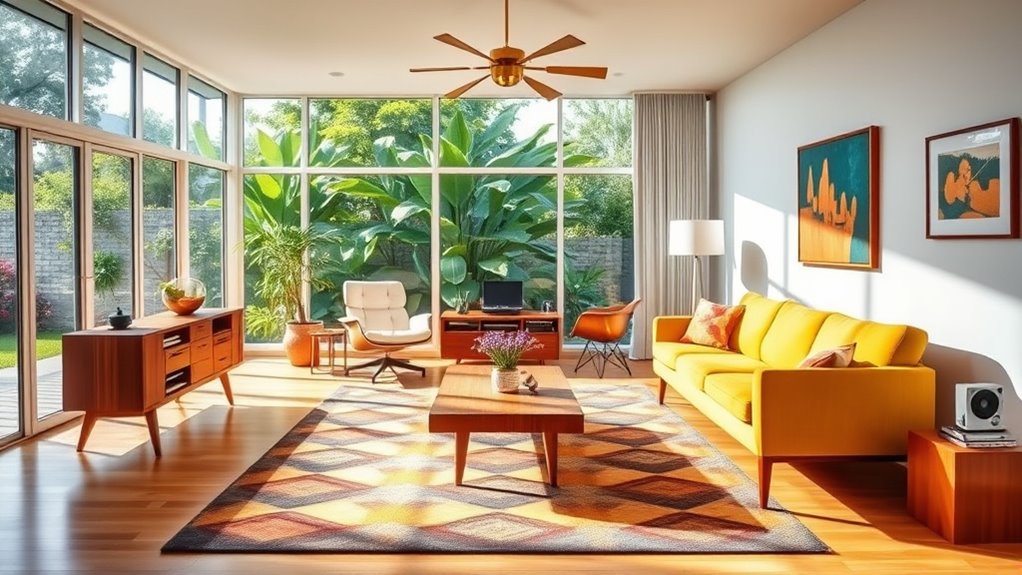
If you’re looking to enhance your space with authentic mid-century modern pieces, several brands and products stand out for their timeless appeal and craftsmanship. Audo Copenhagen masterfully blends vintage-inspired Mid-Century Modern design with sustainable materials, creating iconic pieces that feel both fresh and nostalgic. The Tronk Williams Coffee Table’s sleek rectangular shape and warm wood finish evoke Scandinavian-inspired aesthetics. The GUS Modern Embassy Sofa combines comfort with a classic silhouette, wrapped in luxurious leather. The NYTA Tilt Pendant’s geometric brass form acts as a bold statement lighting piece rooted in organic forms. The Mater Shell Stool’s organic shape and versatile height showcase the movement’s emphasis on natural, flowing design. These iconic pieces and brands help keep Mid-Century Modern relevant and stylish today.
Why Mid-Century Modern Continues to Shape Modern Aesthetics
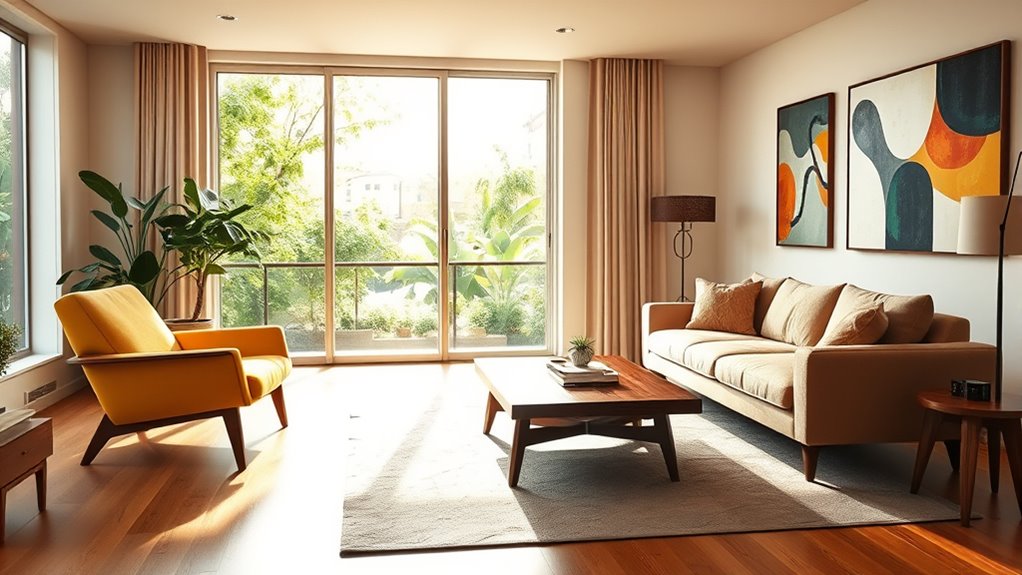
The timeless appeal of Mid-Century Modern design lies in its focus on simplicity, functionality, and natural materials, making it relevant across generations. Its clean lines and organic forms continue to influence modern aesthetics, blending form and function effortlessly. This design style’s emphasis on sustainability aligns with today’s values, as natural materials and minimalism promote eco-friendly living. Iconic furniture pieces and architecture remain highly sought after, often fetching premium prices. Media portrayals in movies and ads keep Mid-Century Modern alive in the public eye, fueling nostalgia and innovation alike. Its core principles have shaped countless designers and trends, proving its enduring relevance.
| Aspect | Influence on Modern Aesthetics |
|---|---|
| Timelessness | Continues to inspire contemporary design |
| Natural Materials | Promotes eco-friendly living |
| Design Style | Blends form and function seamlessly |
| Sustainability | Aligns with modern values and practices |
Frequently Asked Questions
Is Mid-Century Modern Considered Retro?
You’re wondering if mid-century modern is considered retro. While it originated in the 1940s to 1960s with distinctive vintage elements, it’s now seen as a timeless, versatile style. You’ll find it reinterpreted in contemporary design, blending nostalgia with modern aesthetics. So, although it’s rooted in retro history, today’s mid-century modern is more than just vintage; it’s a must-have, enduring style that continues to influence interior trends.
Why Is Mid-Century Modern Coming Back?
Think of mid-century modern as a timeless playlist that keeps finding new fans. You’re drawn to its clean lines, natural materials, and functional beauty, which align with today’s values of simplicity and sustainability. Media and accessible vintage pieces make it easy for you to incorporate this style into your space. Its history and iconic designers add depth, making it more than just trendy—it’s a lasting expression of good design you can enjoy forever.
What Influenced the Mid-Century Modern Style?
You’re curious about what influenced Mid-Century Modern style. It draws inspiration from European modernist movements like Bauhaus and Scandinavian design, emphasizing simplicity and functionality. New materials like plastic and plywood allowed innovative furniture designs. Visionary designers such as Charles and Ray Eames shaped organic forms and clean lines. Post-WWII economic growth and a desire for affordable, mass-produced furniture also played a big role in shaping this timeless style.
How Did Mid-Century Modern Come About?
You see, Mid-Century Modern emerged in the US after WWII, as a response to the ornate styles before. Designers focused on minimalism, functionality, and organic shapes, influenced by European modernists. Advances in manufacturing made sleek, innovative furniture affordable. The 1949 California Design exhibition helped popularize the look, transforming it from a niche style into a mainstream must-have, blending style with practicality for everyday living.
Conclusion
You might think mid-century modern is just a fleeting trend, but its timeless appeal proves otherwise. Imagine walking into a space with sleek lines, warm woods, and iconic furniture—it’s like stepping into a stylish era that still feels fresh. Its blend of form and function creates spaces that are both beautiful and practical. Embrace the style, and you’ll see how it transforms your home into a modern classic that never goes out of fashion.
